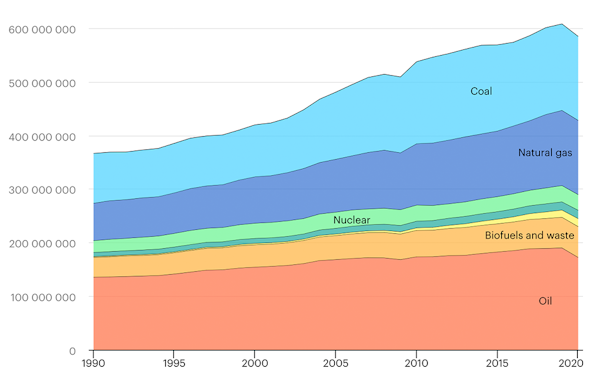SEJournal Online is the digital news magazine of the Society of Environmental Journalists. Learn more about SEJournal Online, including submission, subscription and advertising information.
 |
 |
| A chart showing the world’s total energy supply from 1990 to 2020 by source. It’s one of numerous such graphics that are mostly free to use from the library of the International Energy Agency’s website. Image: International Energy Agency. |
Reporter’s Toolbox: Energy Data With Global Reach — and Policy Fallout
By Joseph A. Davis
Worried about the energy-climate apocalypse? You can get a smorgasbord of data on what’s happening and how big it is from the International Energy Agency.
What IEA offers is data about the global energy situation. But it’s solid data, probably the best available.
It’s not all bad news — just most of it. So it won’t necessarily give you the basis for a classic “data journalism” story, where your own brilliant number crunching produces piercing insights.
Where the data comes from
The IEA is a bit of an odd duck. It is not affiliated with the United Nations, for one thing. Headquartered in Paris, it is a membership association of 31 countries (with some other countries participating at differing levels).
What nearly all of these countries have in common is that they are the major world players in energy markets, mostly as consumers but also as producers. Its members represent 75% of world energy demand. It is very European and quite Western. It does not include China, India, Saudi Arabia or Russia.
The IEA is up to its neck
in policy and not averse
to taking policy positions.
Another thing about the IEA: It is not afraid of policy. By contrast, the U.S. Energy Information Administration is mostly an objective, just-the-facts data supplier. But the IEA is up to its neck in policy and not averse to taking positions. If it has a bias, it is pro-energy. But it is also somewhat agnostic as to which fuels or energy sources should be favored.
It is an enthusiastic chronicler of the energy transition (from fossil fuels to renewables), but it also cheers on nuclear energy. It supports gender equality in the energy industry (currently in an awful state, with IEA statistics to prove it).
Much of the IEA’s data is free and open — but not all. The overview and reports are available to anyone. Some of the raw data is publicly accessible. To get more, you have to register. To get even more, you have to pay.
How to use the data smartly
Even though its data is probably the best you can get about global energy, we have to point out its limits. Its membership is a skewed subset of the world market. It gathers data from nonmember countries, but only about 170 in all.
If you want to know more, we recommend exploring with some of its data browsers. Start with the Energy Statistics Data Browser. It also has browsers and trackers for energy efficiency, carbon capture, oil stocks (inventory), end-uses, hydrogen, climate pledges, critical minerals, electric vehicles and more.
Another cool feature of the IEA site is its chart library. These charts are high quality and many can be used under a Creative Commons license (but do check).
As always, we remind you that shoe-leather and in-person reporting is needed to round out the human side of the data. Groundtruth everything you can.
[Editor’s Note: Be sure to also read a two-part Reporter’s Toolbox on a clean electricity “dashboard” and a trove of power plant data. Plus, get the latest EJToday headlines on energy and be sure to visit our Topic on the Beat: Energy page.]
Joseph A. Davis is a freelance writer/editor in Washington, D.C. who has been writing about the environment since 1976. He writes SEJournal Online's TipSheet, Reporter's Toolbox and Issue Backgrounder, and curates SEJ's weekday news headlines service EJToday and @EJTodayNews. Davis also directs SEJ's Freedom of Information Project and writes the WatchDog opinion column.
* From the weekly news magazine SEJournal Online, Vol. 9, No. 17. Content from each new issue of SEJournal Online is available to the public via the SEJournal Online main page. Subscribe to the e-newsletter here. And see past issues of the SEJournal archived here.












 Advertisement
Advertisement 



